Paper Menu >>
Journal Menu >>
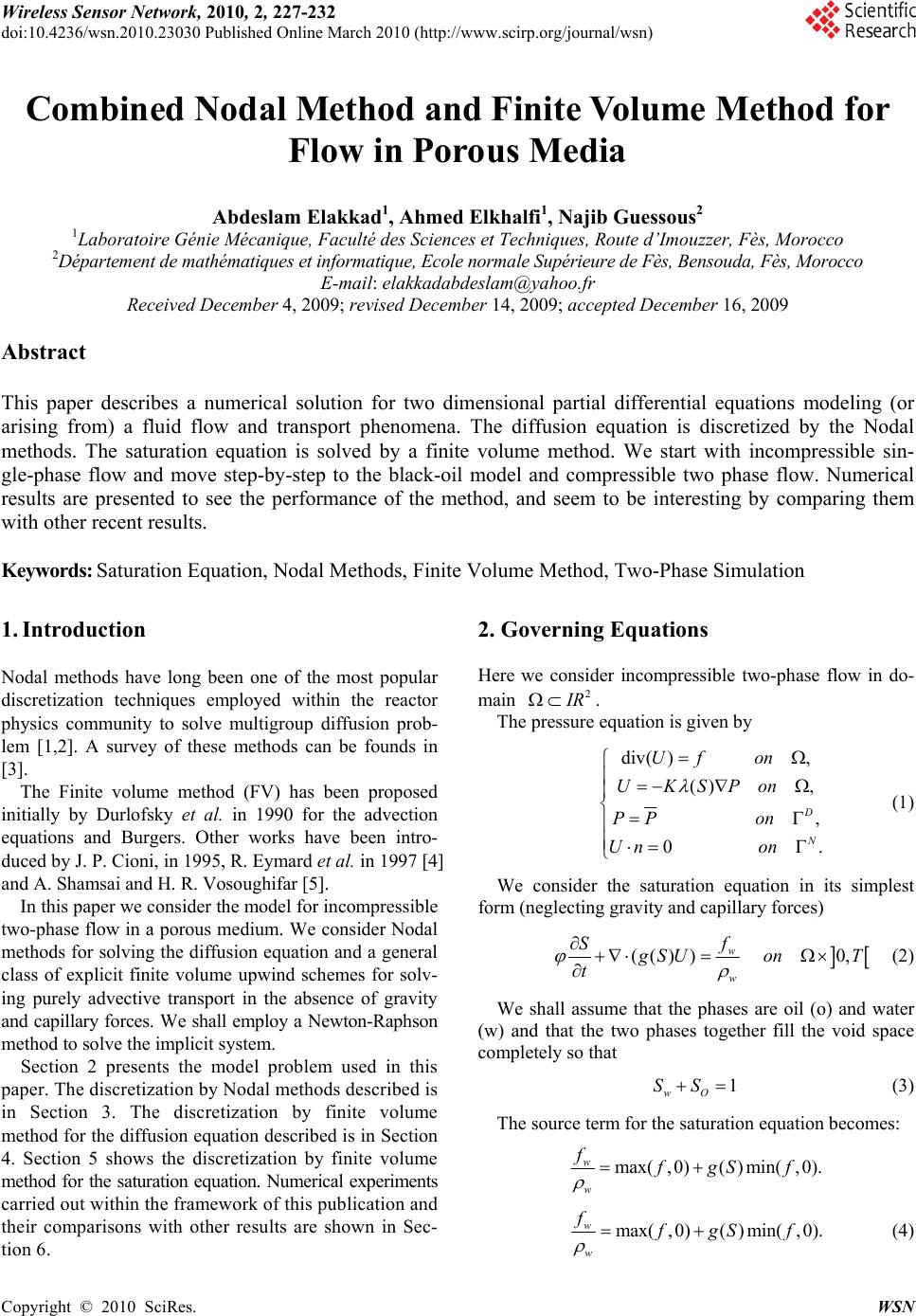 Wireless Sensor Network, 2010, 2, 227-232 doi:10.4236/wsn.2010.23030 Published Online March 2010 (http://www.scirp.org/journal/wsn) Copyright © 2010 SciRes. WSN Combined Nodal Method and Finite Volume Method for Flow in Porous Media Abdeslam Elakkad1, Ahmed Elkhalfi1, Najib Guessous2 1Laboratoire Génie Mécanique, Faculté des Sciences et Techniques, Route d’Imouzzer, Fès, Morocco 2Département de mathématiques et informatique, Ecole normale Supérieure de Fès, Bensouda, Fès, Morocco E-mail: elakkadabdeslam@yahoo.fr Received December 4, 2009; revised December 14, 2009; accepted December 16, 2009 Abstract This paper describes a numerical solution for two dimensional partial differential equations modeling (or arising from) a fluid flow and transport phenomena. The diffusion equation is discretized by the Nodal methods. The saturation equation is solved by a finite volume method. We start with incompressible sin- gle-phase flow and move step-by-step to the black-oil model and compressible two phase flow. Numerical results are presented to see the performance of the method, and seem to be interesting by comparing them with other recent results. Keywords: Saturation Equation, Nodal Methods, Finite Volume Method, Two-Phase Simulation 1. Introduction Nodal methods have long been one of the most popular discretization techniques employed within the reactor physics community to solve multigroup diffusion prob- lem [1,2]. A survey of these methods can be founds in [3]. The Finite volume method (FV) has been proposed initially by Durlofsky et al. in 1990 for the advection equations and Burgers. Other works have been intro- duced by J. P. Cioni, in 1995, R. Eymard et al. in 1997 [4] and A. Shamsai and H. R. Vosoughifar [5]. In this paper we consider the model for incompressible two-phase flow in a porous medium. We consider Nodal methods for solving the diffusion equation and a general class of explicit finite volume upwind schemes for solv- ing purely advective transport in the absence of gravity and capillary forces. We shall employ a Newton-Raphson method to solve the implicit system. Section 2 presents the model problem used in this paper. The discretization by Nodal methods described is in Section 3. The discretization by finite volume method for the diffusion equation described is in Section 4. Section 5 shows the discretization by finite volume method for the saturation equation. Numerical experiments carried out within the framework of this publication and their comparisons with other results are shown in Sec- tion 6. 2. Governing Equations Here we consider incompressible two-phase flow in do- main 2 IR . The pressure equation is given by div( ), () , , 0. D N Uf on UKSPon PP on Un on (1) We consider the saturation equation in its simplest form (neglecting gravity and capillary forces) (() )0, w w f S g SUon T t (2) We shall assume that the phases are oil (o) and water (w) and that the two phases together fill the void space completely so that 1 wO SS (3) The source term for the saturation equation becomes: max( ,0)()min(,0). w w ffgS f max(, 0)() min(,0). w w ffgS f (4) 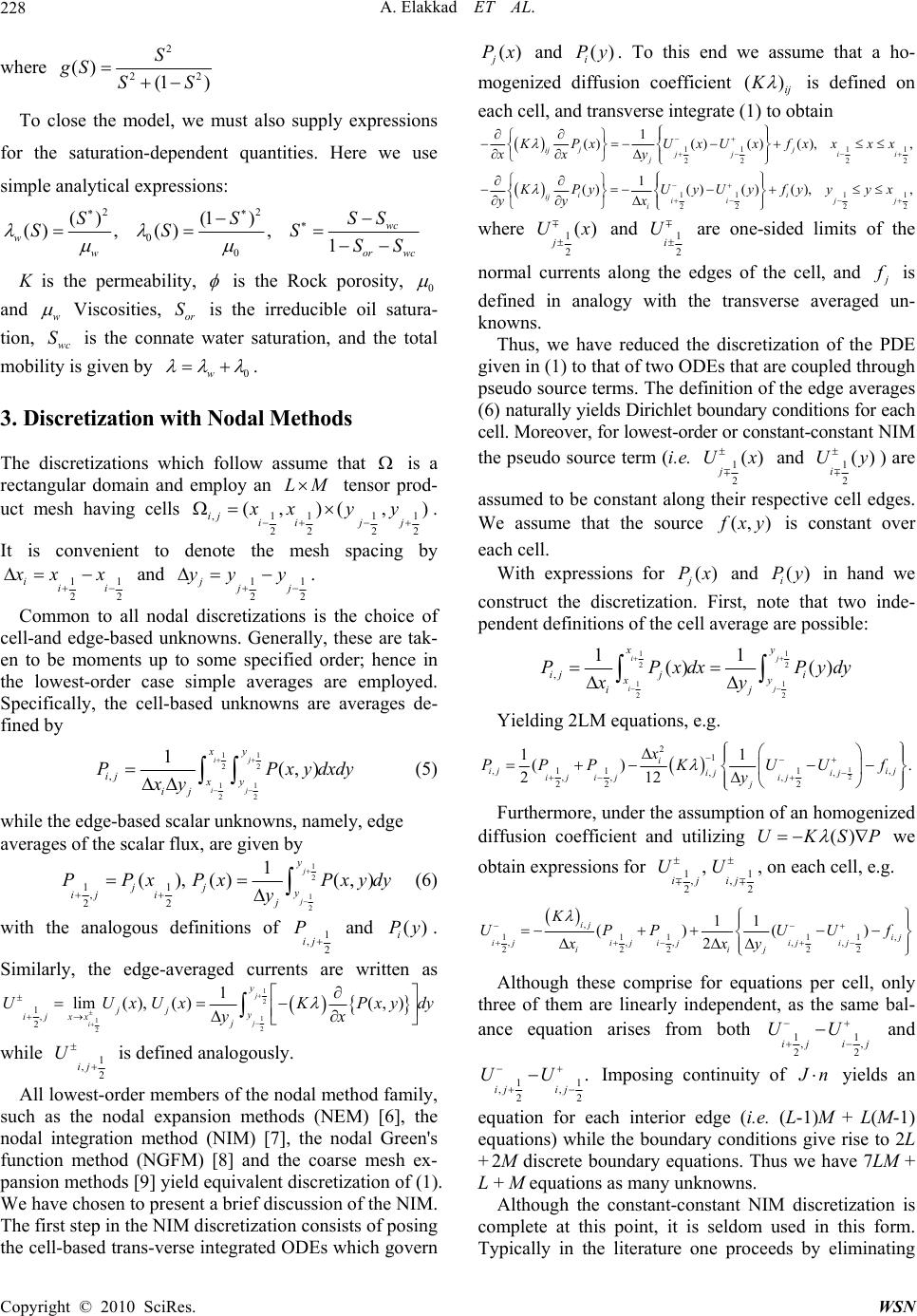 A. Elakkad ET AL. 228 where 2 22 () (1 ) S gS SS To close the model, we must also supply expressions for the saturation-dependent quantities. Here we use simple analytical expressions: 22 0 0 ()(1 ) (), (),1 wc w worwc SS SS SSS SS K is the permeability, is the Rock porosity, 0 and w wc S Viscosities, is the irreducible oil satura- tion, is the connate water saturation, and the total mobility is given by or S 0 w. 3. Discretization with Nodal Methods The discretizations which follow assume that is a rectangular domain and employ an tensor prod- uct mesh having cells LM ,11 1 22 2 (, )() ij ii j xxy y 1 2 , j . It is convenient to denote the mesh spacing by 1 22 iii 1 x xx and 11 22 jjj yy y . Common to all nodal discretizations is the choice of cell-and edge-based unknowns. Generally, these are tak- en to be moments up to some specified order; hence in the lowest-order case simple averages are employed. Specifically, the cell-based unknowns are averages de- fined by 11 22 11 22 , 1(, ) ij ij xy ij xy ij PPxy dxdy xy (5) while the edge-based scalar unknowns, namely, edge averages of the scalar flux, are given by 1 2 1 2 11 , 22 1 (),() (,) j j y jj y ij ij PPxPxPxyd yy (6) with the analogous definitions of 1 ,2 ij P and . Similarly, the edge-averaged currents are written as () i Py 1 2 1 1 2 1, 2 1 lim( ),( )( j j i y jj y ij xx j UUxUx Kydy yx 2 , )Px while 1 ,2 ij U is defined analogously. All lowest-order members of the nodal method family, such as the nodal expansion methods (NEM) [6], the nodal integration method (NIM) [7], the nodal Green's function method (NGFM) [8] and the coarse mesh ex- pansion methods [9] yield equivalent discretization of (1). We have chosen to present a brief discussion of the NIM. The first step in the NIM discretization consists of posing the cell-based trans-verse integrated ODEs which govern and . To this end we assume that a ho- mogenized diffusion coefficient () j Px () i Py () ij K is defined on each cell, and transverse integrate (1) to obtain 11 1 22 2 1 ()()() (),, jj ij jj i j KPx UxUxfxxxx xx y1 2 i 11 1 22 2 1 ()()()(),, ii ij ii j i KPyUyUyfyyyx yy x1 2 j where 1 2 () j Ux and 1 2 i U are one-sided limits of the normal currents along the edges of the cell, and j f is defined in analogy with the transverse averaged un- knowns. Thus, we have reduced the discretization of the PDE given in (1) to that of two ODEs that are coupled through pseudo source terms. The definition of the edge averages (6) naturally yields Dirichlet boundary conditions for each cell. Moreover, for lowest-order or constant-constant NIM the pseudo source term (i.e. 1 2 () j Ux and 1 2 () i Uy) are assumed to be constant along their respective cell edges. We assume that the source (, ) f xy is constant over each cell. With expressions for and in hand we construct the discretization. First, note that two inde- pendent definitions of the cell average are possible: () j Px () i Py 11 22 11 22 , 11 () () ij ij xy ij ji xy ij PPxdxP xy ydy Yielding 2LM equations, e.g. 1 2 21 ,11 1 , , ,, , 22 2 11 () 212 i ij ij ij ij ij ijij j x PPPKUU f y, . Furthermore, under the assumption of an homogenized diffusion coefficient and utilizing () UKSP we obtain expressions for 11 , , 22 , ij ij UU, on each cell, e.g. , 111 11 ,,, ,, 222 22 11 () () 2 ij ij ijij ijijij iij K UPPUU xxy , f Although these compriseations per cell, only th for equ ree of them are linearly independent, as the same bal- ance equation arises from both 11 UU and ,, 22 ij ij 11 ,, 2 . ij ij UU 2 Imposing continuity of J n yields an equation for each interior edge (i.e. (L-1)M + L(M-1) M discretization is co equations) while the boundary conditions give rise to 2L + 2M discrete boundary equations. Thus we have 7LM + L + M equations as many unknowns. Although the constant-constant NI mplete at this point, it is seldom used in this form. Typically in the literature one proceeds by eliminating Copyright © 2010 SciRes. WSN 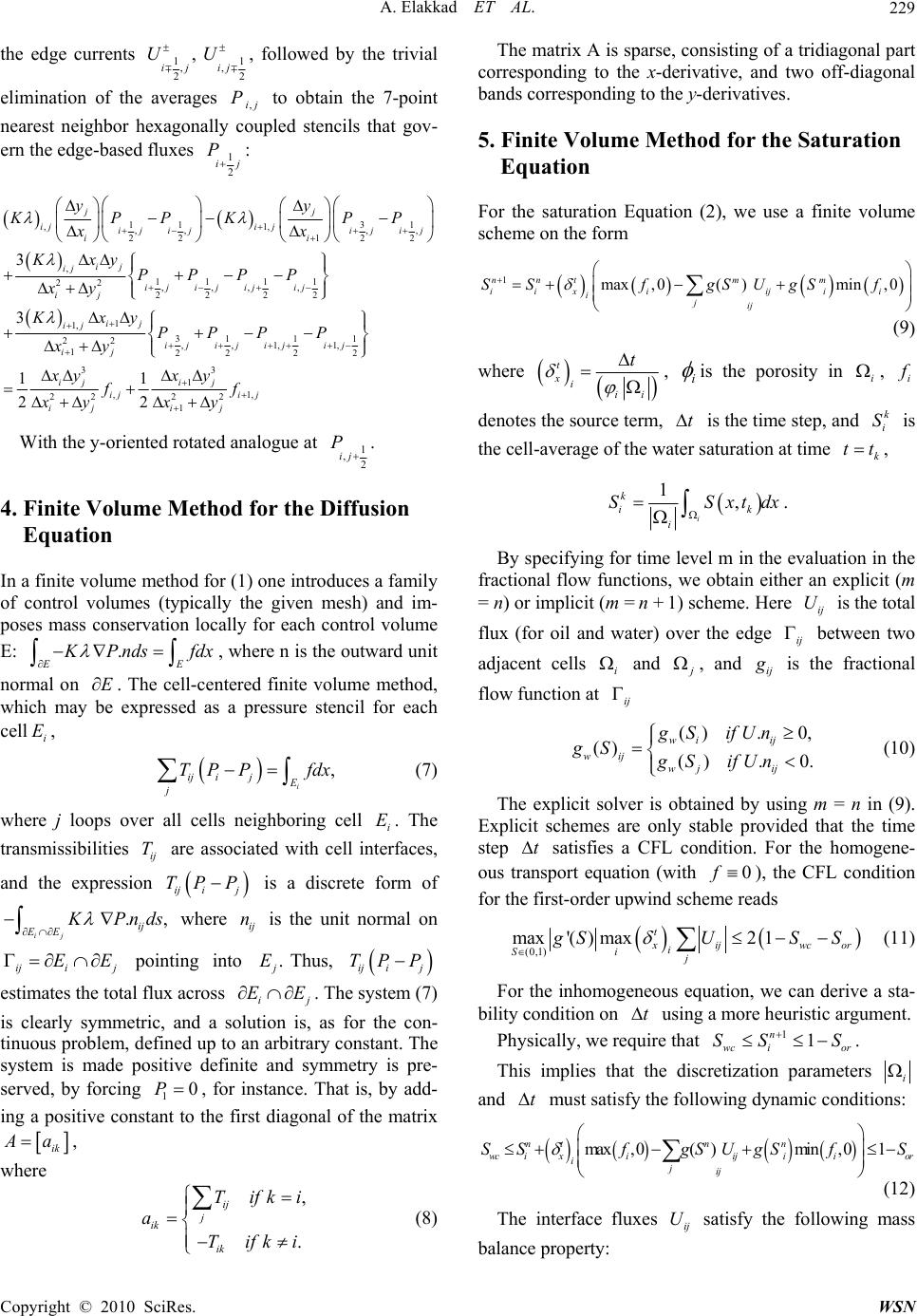 A. Elakkad ET AL.229 the edge currents 11 , UU, followed by the trivial nearest neighbor hexagonally pled stencils that gov- ern the edge-based fluxes ,, 22 ij ij elimination of the averages to obtain the 7-point ,ij P cou 1 P: 2 ij 11 31 ,1, ,, ,, 1 22 22 , 11 11 22 ,,,, 22 22 1 1, 31 1 22 ,,1, 122 2 3 3 jj iji j ij ijij ij ii ij ij ij ij ijij ij ij ij ij ij iji ij yy KPPK PP xx Kxy PPPP xy Kxy PPP P xy 1 1, 2 33 1 ,1, 222 2 1 11 22 j iji j iji j iji j xyx y ff xyx y With the y-oriented rotateanalogue at d 1 ,2 ij P. 4. Finite Volume Method for the Diffusion In e method for (1) one introduces a family f control volumes (typically the given mesh) and im- Equation a finite volum o poses mass conservation locally for each control volume E: . EE K P ndsfdx, where n is the outward unit norm tered finite volume method, whi a pressure stencil for each cell i E, al on E. The cell-cen ch may be expressed as , i ij ijE j TP Pfdx (7) where j loops over all cells neighboring issibilities cell i E. The transm ij T are associated with cell interfaces, and the expressio ij ij TPP is a discrete form of ., ij ij EE n K Pn ds is the unit normal on ting into. j EThus, where ij n ij ij EE poin ij ij TPP al flux across estimates the tot rb ij itra EE. Th is clearly symmetric, and a solution is, as for the con- tinuous problem, defined up tory constant. The system is made positive definite and symmetry is pre- served, by forcing 10P, for instance. That is, by add- ing a positive constant to the first diagonal of the matrix e sm (7)yste an a ik A a, where , . ij j ik ik Tifki a Tifki (8) The matrix A is sparse, consisting of a tridiagonal part corresponding to the x-derivative, and t bands corresponding to the y-derivatives. (9) where wo off-diagonal 5. Finite Volume Method for the Saturation Equation For the saturation Equation (2), we use a finite volume scheme on the form 1max, 0()min, 0 nntm m iixiij i i ijij SSfgSUgS f t xi ii t, i is the porosity in i, i f denotes the source term, t er is the time step, and -average of the w k i S is the cellatsaturation at time k t, t 1, i k ik i SSxtdx. By specifying for time level m in the evaluation in the fractional flow functions, we obtain either an explicit (m = n) or implicit (m = n + 1) scheme. Here is the total flu ij U x (for oil and water) over the edge ij between two adjacent cells i and j , and ij g is the fractional flow function at ij ) 0, () wi gS ifU gS (10) ( . (). 0. ij wij wj ij n gS ifUn The explicit solver is obtained by using m = n in (9). Explicit schemes are only stable provided step that the time t satisfies a CFL condition. For the homogene- ous transport equation (with 0f), the CFL condition for the first-order upwind scheme reads (0,1) max'() max21 t x ijwc or i Si j g SUSS (11) For the inhomogeneous equation, we can derive a sta- bility condition on t using a more heuristic arg Physically, we require that ument. 11 n wc ior SS S. This implies that the discretization parameters i and t must satisfy the following dynamic conditions: max, 0()min, 01 ntn n i xiijii jij SfgSUgS f (12) wc or i S S The interface fluxes satisfy the following mass balance property: ij U Copyright © 2010 SciRes. WSN 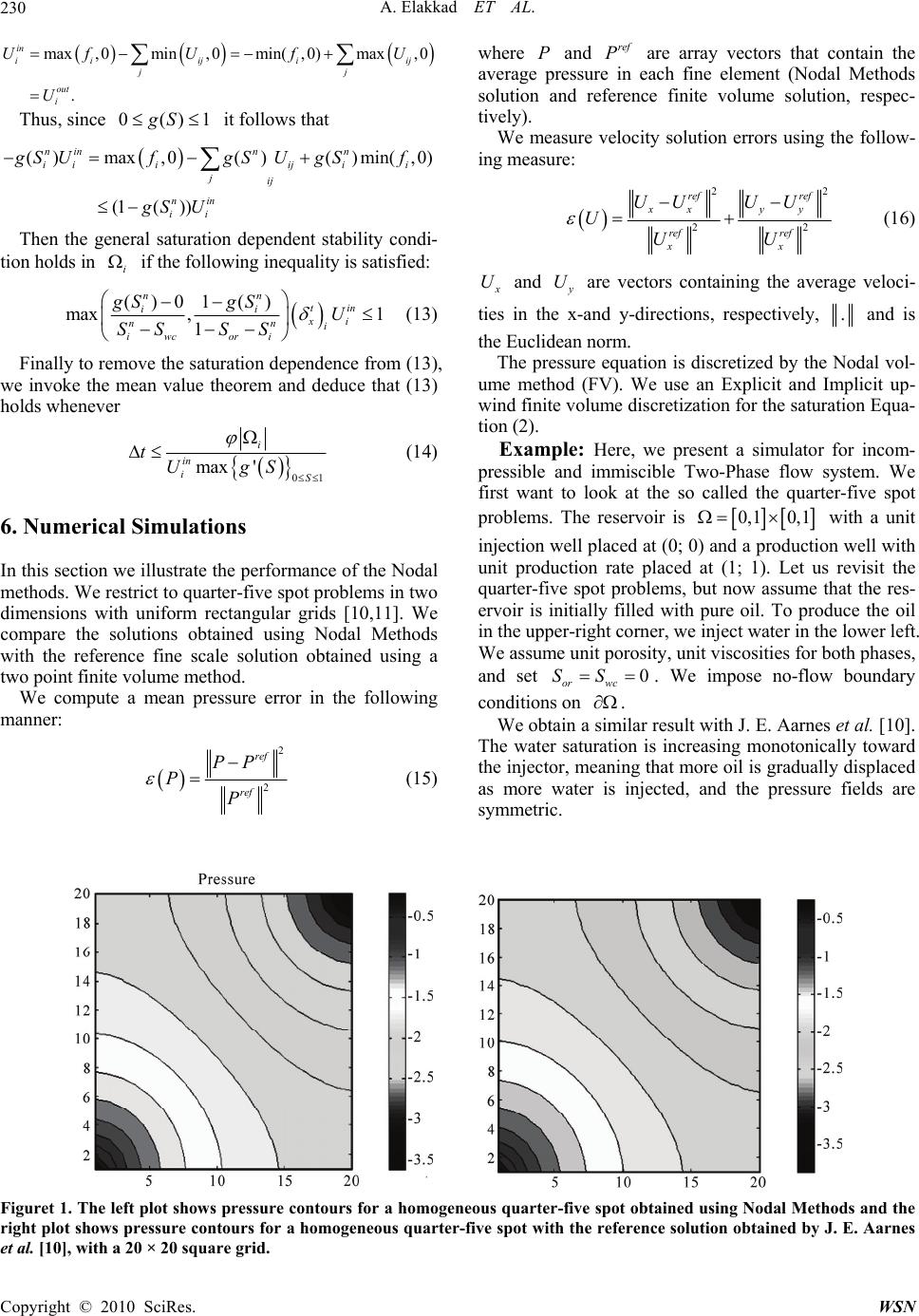 A. Elakkad ET AL. Copyright © 2010 SciRes. WSN 230 max,0min,0min(,0)max ,0 . in iiij i jj out i UfUfU U Thus, since 0()1gS it follows that ij where and are array vectors that contain the average pressure in each fine eleme solution and reference finite volume solution, respec- tively). e Pref P nt (Nodal Methods We masure velocity solution errors using the follow- ing measure: () max ninn n ii gS U,0 ()()min(,0) (1()) iij ii jij nin ii fgS UgSf gS U 22 ref ref Then the general saturation dependent stability condi- tio if the foll is satisfied: n holds in owing inequality i ()01 () max ,1 1 nn tin ii xi nn i iwcori gSgS U SSS S (13) Finally to remove the saturation dependence from (13), w er e invoke the mean value theorem and deduce that (13) holds whenev 01 max ' i in iS tUgS In this section we illustrate the performance of the Nodal methods. We restrict to quarter-five spot pr dimensions with uniform rectangular grids [10,11]. We ompare the solutions obtained using Nodal Methods lution obtained using a (14) 6. Numerical Simulations oblems in two c with the reference fine scale so two point finite volume method. We compute a mean pressure error in the following manner: 2 2 ref ref PP P P (15) 22 xx yy ref ref U UU (16) xx UU UU x U and are vectors containing the average veloci- ties in the x-and y-directions, respectively, y U . and is the Euclidean norm. T ss um tio . The reservoir is he preure equation is discretized by the Nodal vol- e method (FV). We use an Explicit and Implicit up- wind finite volume discretization for the saturan Equa- tion (2). Example: Here, we present a simulator for incom- pressible and immiscible Two-Phase flow system. We first want to look at the so called the quarter-five spot problems 0,1 0,1 pure oil. To pro with a unit injection well placed at (0; 0) and a production well with unit production rate placed at (1; 1). Let us revisit the quarter-five spot problems, but now assume that the res- ervoir is initially filled withduce the oil in the upper-right corner, we inject water in the lower left. We assume unit porosity, unit viscosities for both phases, and set 0 or wc SS . We impose no-flow boundary conditions on . We obtain a similar result with J. E. Aarnes et al. [10]. The water saturation is increasing monotonically toward the injectohat more oil is gradually displaced as more water is injected, r, meaning t and the pressure fields are symmetric. Figuret 1. The left plot shows pressure contours for a homogeneous quarter-five spot obtained using Nodal Methods and the right plot shows pressure contours for a homogeneous quarter-five spot with the reference solution obtained by J. E. Aarnes et al. [10], with a 20 × 20 square grid. 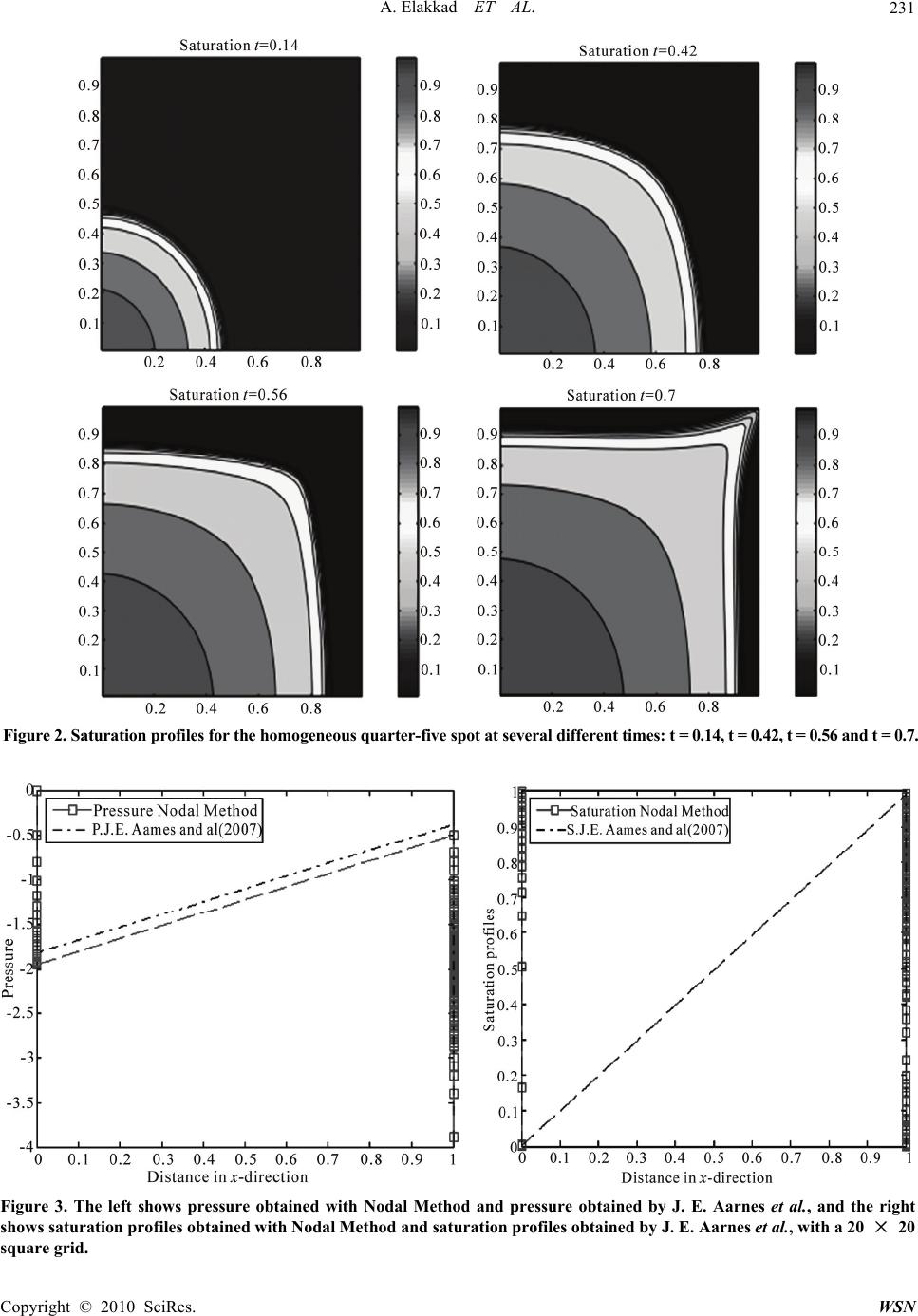 A. Elakkad ET AL.231 Figure 2. Saturation profiles for the homogeneous quarter-fiv at several different times: t = 0.14, t = 0.42, t = 0.56nd t = 0.7. e spot a Figure 3. The left shows pressure obtained with Nodal Method and pressure obtained by J. E. Aarnes et al., and the right shows saturation profiles obtained with Nodal Method and saturation profiles obtained by J. E. Aarnes et al., with a 20 × 20 square grid. Copyright © 2010 SciRes. WSN 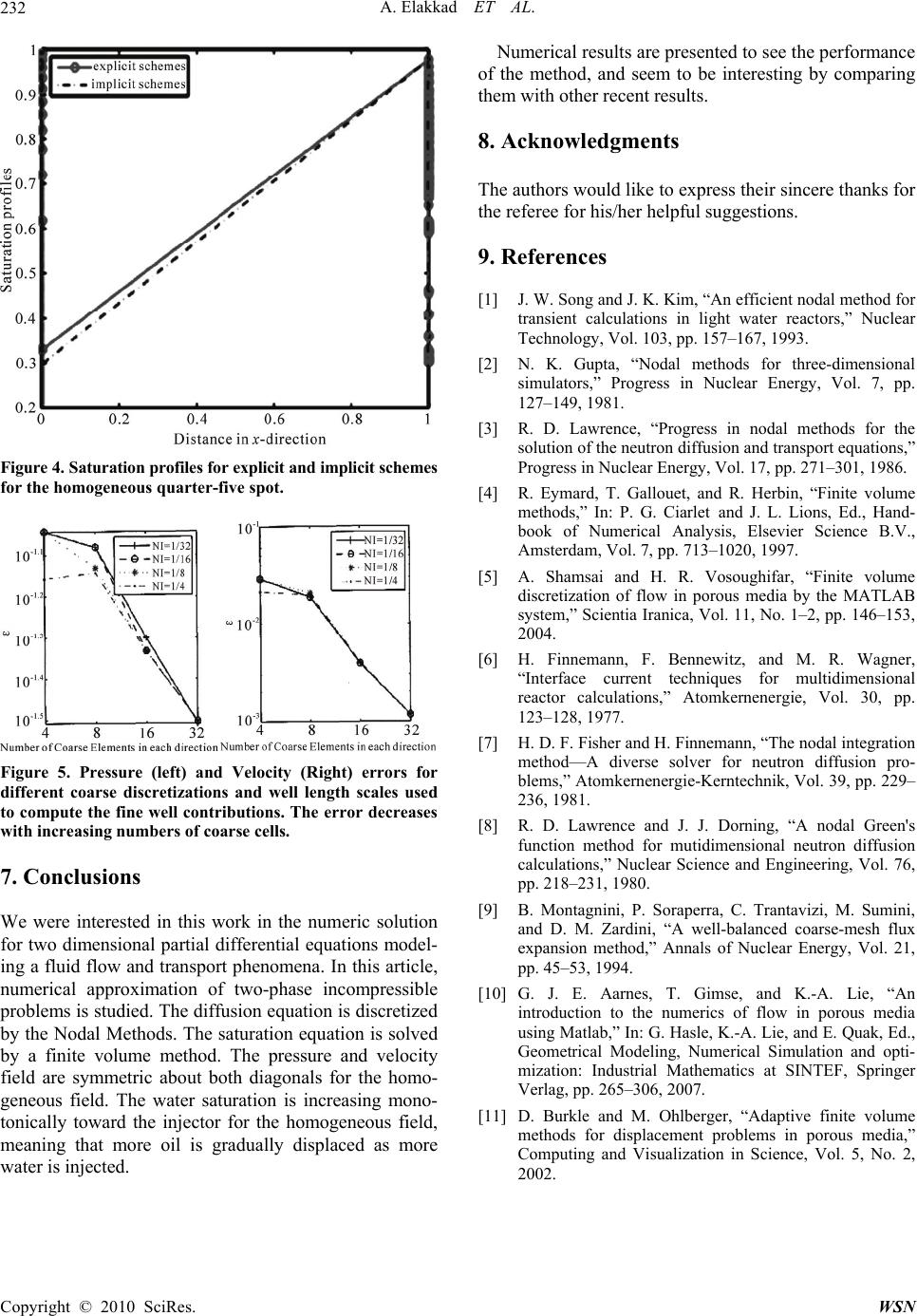 A. Elakkad ET AL. Copyright © 2010 SciRes. WSN 232 Figure 4. Saturation profiles for explicit and implicit schemes for the homogeneous quarter-five spot. Figure 5. Pressure (left) and Velocity (Right) errors for different coarse discretizations and well length scales used to compute the fine well contributions. The error decreases with increasing numbers of coarse cells. 7. Conclusions We were interested in this work in the numeric solutio pressible problems is studied. The diffusion equation is discretized by the Nodal Methods. The saturation equation is solved by a finite volume method. The pressure and velocity field are symmetric about both diagonals for the homo- geneous field. The water saturation is increasing mono- tonically toward the injector for the homogeneous field, meaning that more oil is gradually displaced as more water is injected. Numerical results are presented to see the performance of the method, and seem to be interesting by comparing them with other recent results. 8. Acknowledgments The authors would like to express their sincere thanks for the referee for his/her helpful suggestions. 9. References [1] J. W. Song and J. K. Kim, “An efficient nodal method for transient calculations in light water reactors,” Nuclear Technology, Vol. 103, pp. 157–167, 1993. [2] N. K. Gupta, “Nodal methods for three-dimensional simulators,” Progress in Nuclear Energy, Vol. 7, pp. 127–149, 1981. R. D. Lawrence, “Progress in nodal methods for the solution of the neutron diffusion and transport equations, methods,” In: P. G. Ciarlet and J. L. Lions, Ed., Hand- book of Numerical Analysis, Elsevier Science B.V., . 1–2, pp. 146–153, F. Bennewitz, and M. R. Wagner, “Interface current techniques for multidimensional thod,” Annals of Nuclear Energy, Vol. 21, pp. 45–53, 1994. A. Lie, and E. Quak, Ed., Geometrical Modeling, Numerical Simulation and opti- thematics at SINTEF, Springer 7. Vol. 5, No. 2, [3] ” Progress in Nuclear Energy, Vol. 17, pp. 271–301, 1986. [4] R. Eymard, T. Gallouet, and R. Herbin, “Finite volume Amsterdam, Vol. 7, pp. 713–1020, 1997. [5] A. Shamsai and H. R. Vosoughifar, “Finite volume discretization of flow in porous media by the MATLAB system,” Scientia Iranica, Vol. 11, No 2004. [6] H. Finnemann, reactor calculations,” Atomkernenergie, Vol. 30, pp. 123–128, 1977. [7] H. D. F. Fisher and H. Finnemann, “The nodal integration method—A diverse solver for neutron diffusion pro- blems,” Atomkernenergie-Kerntechnik, Vol. 39, pp. 229– 236, 1981. [8] R. D. Lawrence and J. J. Dorning, “A nodal Green's function method for mutidimensional neutron diffusion calculations,” Nuclear Science and Engineering, Vol. 76, pp. 218–231, 1980. [9] B. Montagnini, P. Soraperra, C. Trantavizi, M. Sumini, and D. M. Zardini, “A well-balanced coarse-mesh flux expansion me n for two dimensional partial differential equations model- ing a fluid flow and transport phenomena. In this article, umerical approximation of two-phase incomn[10] G. J. E. Aarnes, T. Gimse, and K.-A. Lie, “An introduction to the numerics of flow in porous media using Matlab,” In: G. Hasle, K.- mization: Industrial Ma Verlag, pp. 265–306, 200 [11] D. Burkle and M. Ohlberger, “Adaptive finite volume methods for displacement problems in porous media,” Computing and Visualization in Science, 2002. |

